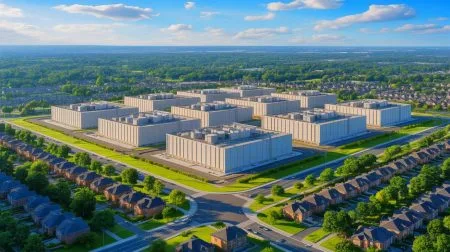| IN A NUTSHELL |
|
Data centers serve as the backbone of our digital world, supporting everything from social media to online banking. However, these essential facilities are also notorious for their colossal energy consumption. Recent findings by researchers from the University of Waterloo suggest a surprisingly simple solution: adjusting a few lines of code could significantly cut energy use. This revelation could revolutionize the way data centers operate, offering both environmental and economic benefits.
The Hidden Energy Cost of Data Centers
Data centers are often described as the digital world’s unseen workhorses. They power the internet and its myriad services, consuming vast amounts of energy in the process. As the demand for digital services climbs, so does the energy footprint of these centers. The massive energy consumption is mainly due to the constant operation of servers, cooling systems, and other infrastructure. This not only impacts the environment but also represents a significant operational cost for companies.
One of the primary concerns is the heat generated by servers, which necessitates robust cooling systems. These systems, while essential, add to the overall energy demand. With energy prices rising and sustainability becoming a global priority, there is an urgent need for innovative solutions. The simple coding modification proposed by the University of Waterloo researchers could be a game-changer, offering a practical approach to reducing energy consumption without compromising performance.
A Revolutionary Coding Tweak
The research team from the University of Waterloo has identified a potential remedy for the energy woes of data centers. By modifying just 30 lines of code within the Linux kernel’s protocol stack, energy consumption could be reduced by 30 to 45 percent. This is a significant breakthrough, considering that Linux is the operating system of choice for most global data centers. The Linux kernel acts as the core interface between a computer’s hardware and its processes, and optimizing its efficiency can lead to substantial energy savings.
The modification involves reorganizing operations within the Linux network protocol stack to enhance efficiency. This approach improves network performance by reducing unnecessary processor interruptions during high-traffic periods. As a result, it maintains low latency during quieter times, thereby reducing overall energy use. This innovative solution exemplifies how small changes in code can have a profound impact on energy efficiency.
Testing and Implementation
The researchers didn’t stop at theorization; they tested their solution in real-world scenarios. Following successful trials, the modified code was submitted to the Linux community and is now part of the latest kernel release, version 6.13. This development not only underscores the practical viability of the solution but also its potential for widespread adoption. As Linux is open-source, the new code is available for anyone to implement, fostering a collaborative effort toward energy efficiency.
The adoption of this modification could lead to a ripple effect across industries, as companies seek to lower operational costs and meet sustainability targets. The open-source nature of Linux ensures that these improvements can be quickly disseminated, allowing for rapid implementation and adoption globally. This could be a pivotal moment for data centers worldwide, as they strive to balance performance with environmental responsibility.
Looking Toward a Sustainable Future
The implications of this research extend beyond immediate energy savings. By demonstrating the potential of software optimization to reduce energy use, the study opens the door for further innovations in data center management. As technology evolves, so too will the strategies for achieving sustainability in the digital realm. This approach could inspire other sectors to explore similar methods for reducing their environmental impact.
The journey toward sustainable data centers is ongoing, and this breakthrough is a significant step in the right direction. As companies and consumers become more conscious of their environmental footprint, the demand for efficient and sustainable technological solutions will only increase. The question remains: how will other industries harness the power of coding to create a more sustainable future?
Did you like it? 4.5/5 (28)








This is amazing! Who knew a few lines of code could make such a huge difference? 👏
Is this change applicable to all versions of Linux or just the latest one?
Seems too good to be true. What’s the catch? 🧐
30% power savings with just 30 lines of code? That’s mind-blowing! 🤯
I wonder how this will affect performance during peak traffic times.
Can this modification be applied to other operating systems apart from Linux?
Thank you for sharing such an insightful article! 🌟